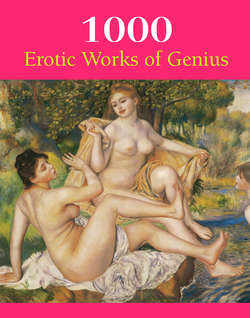1000 Erotic Works of Genius

Реклама. ООО «ЛитРес», ИНН: 7719571260.
Оглавление
Victoria Charles. 1000 Erotic Works of Genius
Introduction
Erotic art or pornography?
From Prehistory and Primitive Forms to Antiquity and the Perfection of the Body
The Middle Ages: A Return to Prudery
The Renaissance: The Golden Age of the Body. 1453–1563
The Elegance of the Body. 1563–1810
Realism and the Body. 1810–1922
The Decades of Promise. 1922–1960
The Revolution of the Body. 1960–2000s
Chronology
Отрывок из книги
The term ‘Erotic Art’ is muddied by a miasma of ambiguous terms. Art and pornography, sexuality and sensuality, obscenity and morality are all involved to such an extent that it seems almost impossible to reach an objective definition, which is not unusual in the history of art. How is it possible to speak of erotic art?
This much is certain: the depiction of a sexual activity alone does not raise a work to the nobility that is erotic art. To identify erotic art only with its content would reduce it to one dimension, just as it is not possible to distinguish artistic and pornographic depictions only by describing their immoral contents. The view that erotic works are created solely for sexual arousal and so cannot be art is erroneous as well. Does the creative imagination brought to erotic art distinguish it from pornography? Yet pornography is also a product of imagination. It has to be more than just a depiction of sexual reality, however, or who would buy it? Günter Schmidt states that pornography is “constructed like sexual fantasy and daydreams, just as unreal, megalomaniacal, magical, illogical, and just as stereotypical.” Erotic daydreams – they are the subject of erotic art as well. Those making a choice between art and pornography may have already decided against the first one. Pornography is a moralising defamatory term. What is art to one person is the Devil’s handiwork to another. The mixing of aesthetic with ethical-moralistic questions dooms every clarification process right from the start.
.....
Aphrodite became a common subject for Greek sculptors in the fourth century B. C. E. and later, because her renowned beauty provided an acceptable excuse for an erotic representation of the female body. She is sometimes shown, as here, with her son Eros, known to the Romans as Cupid, and in later art as “putti,” the winged babies symbolising earthly and divine love. In Roman art and mythology, Aphrodite became Venus, goddess of love. To the Romans she had a more elevated status, seen as the progenitor of the line of Caesar, Augustus, and the Julio-Claudian emperors, and by extension as an embodiment of the Roman people. This playful depiction of Aphrodite and Eros, or Venus and Cupid, is more suggestive of the Greek view of Aphrodite, who saw her not only as the symbol of sensual beauty, but also as occasionally silly and humorous.
43. Anonymous, Capitoline Venus, Roman copy after a Greek original created by Praxiteles, 3rd century B. C. E. Marble, h: 193 cm. Musei Capitolini, Rome (Italy).
.....